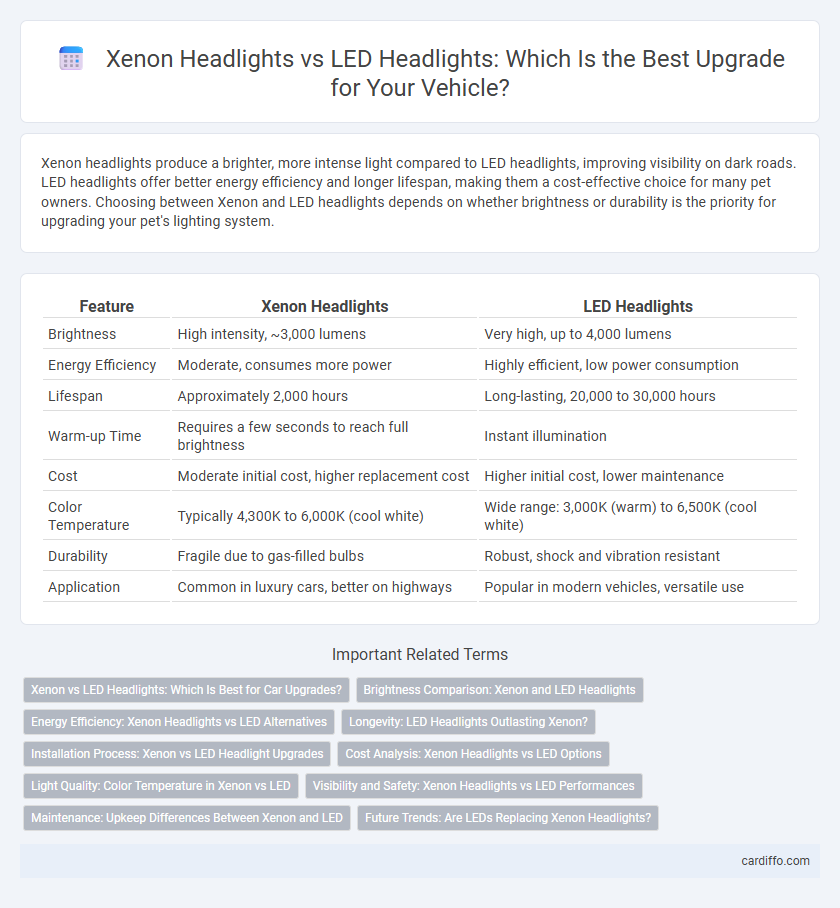Xenon headlights produce a brighter, more intense light compared to LED headlights, improving visibility on dark roads. LED headlights offer better energy efficiency and longer lifespan, making them a cost-effective choice for many pet owners. Choosing between Xenon and LED headlights depends on whether brightness or durability is the priority for upgrading your pet's lighting system.
Table of Comparison
| Feature | Xenon Headlights | LED Headlights |
|---|---|---|
| Brightness | High intensity, ~3,000 lumens | Very high, up to 4,000 lumens |
| Energy Efficiency | Moderate, consumes more power | Highly efficient, low power consumption |
| Lifespan | Approximately 2,000 hours | Long-lasting, 20,000 to 30,000 hours |
| Warm-up Time | Requires a few seconds to reach full brightness | Instant illumination |
| Cost | Moderate initial cost, higher replacement cost | Higher initial cost, lower maintenance |
| Color Temperature | Typically 4,300K to 6,000K (cool white) | Wide range: 3,000K (warm) to 6,500K (cool white) |
| Durability | Fragile due to gas-filled bulbs | Robust, shock and vibration resistant |
| Application | Common in luxury cars, better on highways | Popular in modern vehicles, versatile use |
Xenon vs LED Headlights: Which Is Best for Car Upgrades?
Xenon headlights emit a brighter, more intense light with a color temperature typically around 4,300K to 6,000K, offering superior visibility compared to traditional halogen bulbs, making them ideal for long-distance illumination on road upgrades. LED headlights provide greater energy efficiency, longer lifespan (up to 30,000 hours), and faster response times, ensuring lower maintenance costs and improved safety for modern car upgrades. Choosing between Xenon and LED headlights depends on priorities such as brightness intensity, energy consumption, durability, and the specific driving conditions that will benefit the vehicle upgrade most.
Brightness Comparison: Xenon and LED Headlights
Xenon headlights produce a high-intensity discharge light with brightness typically measured between 3,000 and 3,500 lumens, offering superior illumination compared to traditional halogen bulbs. LED headlights provide brightness ranging from 2,000 to 4,000 lumens, delivering a more focused and efficient light beam that enhances visibility and reduces glare. Both technologies improve road safety, but LED headlights offer better energy efficiency and longer lifespan while maintaining comparable or higher brightness levels than Xenon.
Energy Efficiency: Xenon Headlights vs LED Alternatives
Xenon headlights consume more power due to their gas-discharge technology, typically averaging around 35 watts per bulb, whereas LED headlights offer superior energy efficiency, often using 15 to 20 watts while providing comparable or greater brightness. LEDs generate less heat, reducing energy loss and extending the lifespan of the lighting system, making them more sustainable and cost-effective over time. Vehicles equipped with LED headlights benefit from reduced electrical load, which can improve overall fuel efficiency and lower energy consumption in electric cars.
Longevity: LED Headlights Outlasting Xenon?
LED headlights offer superior longevity compared to Xenon headlights, typically lasting up to 30,000 to 50,000 hours versus Xenon's average lifespan of 2,000 to 3,000 hours. LEDs maintain consistent brightness and performance over time, reducing the frequency of replacements and maintenance costs. This extended lifespan makes LED headlights a more durable and cost-effective lighting upgrade for modern vehicles.
Installation Process: Xenon vs LED Headlight Upgrades
Xenon headlight upgrades typically require a ballast and additional wiring, making the installation process more complex and time-consuming compared to LED headlights. LED headlight upgrades are generally plug-and-play with minimal modifications, offering a quicker and more straightforward installation. Choosing between Xenon and LED depends on vehicle compatibility and desired brightness, with LED often preferred for ease of upgrade.
Cost Analysis: Xenon Headlights vs LED Options
Xenon headlights generally have a higher initial cost, ranging from $300 to $700 per pair, compared to LED headlights which typically cost between $150 and $500. Although Xenon bulbs consume less power than traditional halogens, LED headlights offer greater energy efficiency and longer lifespan, reducing replacement and maintenance expenses over time. Total cost of ownership favors LEDs due to their durability and lower operational costs despite a comparable upfront investment.
Light Quality: Color Temperature in Xenon vs LED
Xenon headlights typically emit light with a color temperature around 4,300K to 6,000K, producing a bright white to slightly bluish hue that enhances night visibility and reduces eye strain. LED headlights often offer adjustable color temperatures ranging from 5,000K to 6,500K, delivering a sharper, more focused beam with higher color rendering accuracy. The choice between Xenon and LED impacts light quality, with LED headlights providing consistent brightness and cooler color tones for improved road illumination.
Visibility and Safety: Xenon Headlights vs LED Performances
Xenon headlights produce a brighter, more intense white-blue light that enhances visibility significantly in low-light and foggy conditions, improving overall safety. LED headlights offer instant illumination with better energy efficiency and longer lifespan while providing a wide, even beam that reduces glare and enhances peripheral vision. Both technologies improve nighttime driving safety, but LEDs deliver superior color rendering and quicker response times for hazard detection.
Maintenance: Upkeep Differences Between Xenon and LED
Xenon headlights require more frequent maintenance due to their shorter bulb lifespan, typically lasting around 2,000 hours compared to LED headlights, which can last up to 30,000 hours with minimal degradation. Xenon bulbs need periodic replacement to maintain brightness and performance, while LED systems often come integrated with durable circuitry but may require complex repairs if damaged. Maintenance costs for Xenon headlights tend to be higher over time, whereas LED headlights offer lower long-term upkeep expenses and greater reliability.
Future Trends: Are LEDs Replacing Xenon Headlights?
LED headlights are rapidly replacing Xenon headlights due to their superior energy efficiency, longer lifespan, and enhanced brightness. Advances in LED technology continue to improve light distribution and color temperature, making them a preferred choice for modern vehicles. Industry trends indicate a growing shift towards LED systems, driven by regulatory support and consumer demand for smarter, eco-friendly lighting solutions.
Xenon headlights vs LED headlights Infographic

 cardiffo.com
cardiffo.com